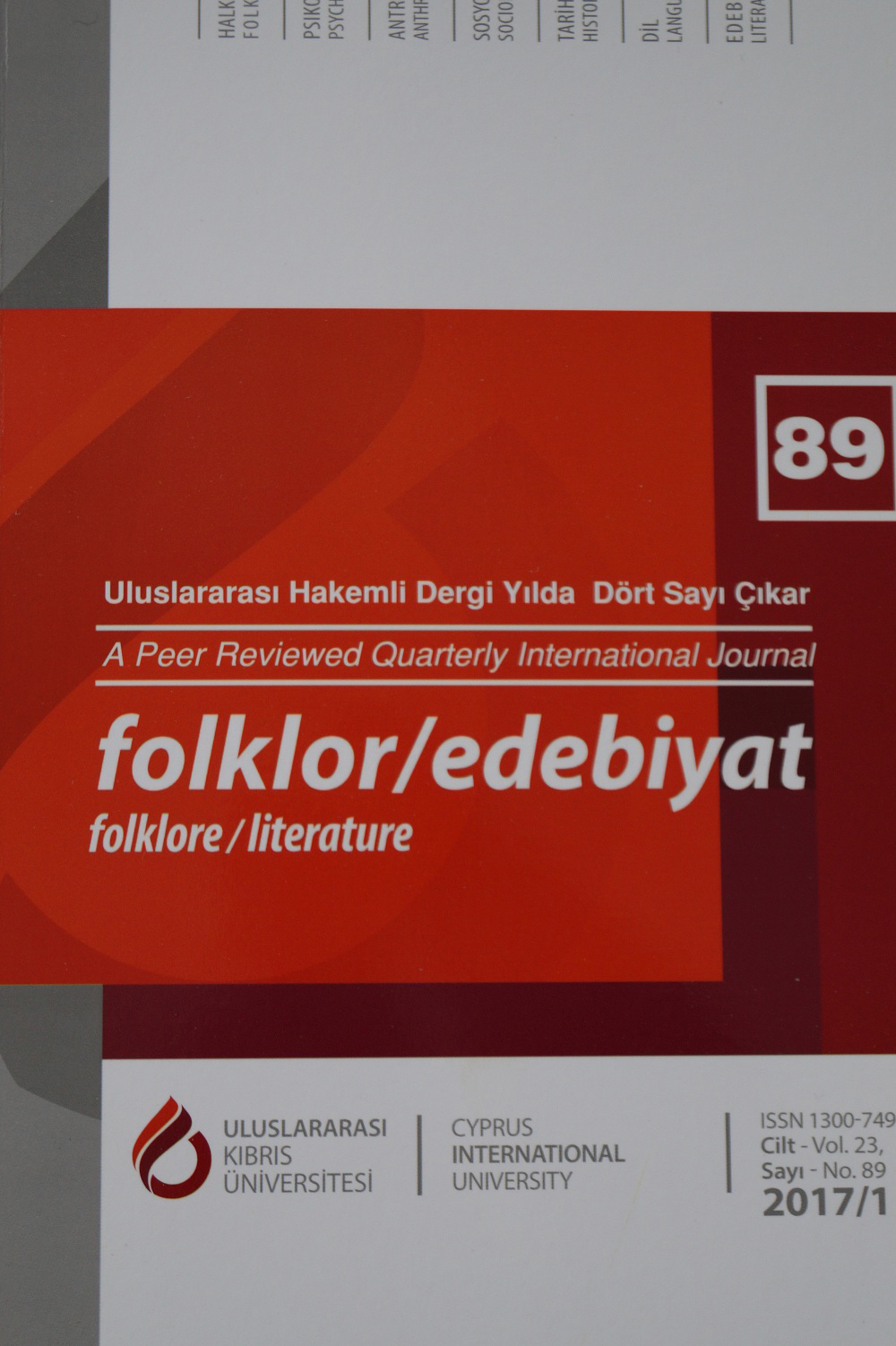
JOURNAL OF FOLKLORE/LITERATURE
Cyprus International University
DOI: 10.5897/UJ-FOLKLORE
Email: folkloredebiyat@ciu.edu.tr
HERO’S JOURNEY IN THE EPIC OF GILGAMESH AND THE CLASH OF THE TITANS
DOI: 10.5897/UJ-FOLKLORE.17.005.1 | Article Number: E9331D025 | Vol.89 (1) - January 2017
Author: Gürçay Serdar
Keywords: Hero, Monster, Gilgamesh, Perseus, Mythology
This work is about the interpretation of “Epic of Gilgamesh” and the movie named “Clash of the Titans” in comparative mythology from the view point of “hero’s journey”. Epic of Gilgamesh is the first known epic poetry from BC 2100. It tells the adventures of King Gilgamesh and his best friend Enkidu. Gilgamesh believed to be Uruk king lived and ruled in Mesopotamia. Uruk is a Sumerian city. Once a tyrant, Gilgamesh turned into a hero. A savage young man Enkidu becomes his companion, a deep bond occurs between them. Later on Enkidu loses his synergy with nature, becomes week and finally dies. In return, Gil- gamesh begins to seek immortality and faces the facts of life. On the other hand, the movie Clash of the Titans covers the legend of Perseus which is recorded from BC 700s. Perseus is accepted as one of the most important heroes in ancient Greek mythology. In this legend the gods are ruthless and humans are in distress. It tells the adventures of Perseus, his flying horse Pegasus and his companions in a quest for saving the city of Argos from being destro- yed by a giant monster. For the Epic of Gilgamesh the book of İsmail Gezgin (2009) is used as the source material and the latest movie of Clash of the Titans directed by Louis Leterrier (2010) is selected. In the introduction section of this work, the terms of “hero and monster” is covered. In the first section, “the journey of the hero” concept is explained. In this part “cha- racter archetypes” and “character cycle” concepts are also involved in detail. In the following sections, heroes and monsters of “Epic of Gilgamesh” and the movie “Clash of the Titans” are studied respectively. Also each work is analyzed in terms of “character archetypes” and “character cycle”. The final section is about the comparison of heroes and monsters in the epic and the movie. The reason –why these works of art are chosen– is; one belongs to the past where the other is an echo of a modern variant. The harmony between oral literature of ancient times and cinema art of modern times became a subject of study.
Andromeda, [2016], https://en.wikipedia.org/wiki/Andromeda_(mythology).
Arketipler, [17.08.2016], http://www.psikolik.com/threads/analitik-psikoloji-arketipler.797. Armstrong, K. (2005). Mitlerin Kısa Tarihi, İstanbul: Merkez Yayıncılık.
Augustine of Hippo, [2016], https://en.wikipedia.org/wiki/Augustine_of_Hippo.
Beacham, T., Hay, P., Manfredi, M. (2010). Titanların Savaşı, ABD: Warner Bros. Enterta- inment.
Bes, [01.09.2016], https://en.wikipedia.org/wiki/Bes.
Canavar, [2016], http://www.etimolojiturkce.com/kelime/canavar.
Campbell, J. (1949). The Hero with a Thousand Faces, Kaliforniya: New World Library. Campbell, J. (2010). Kahramanın Sonsuz Yolculuğu, İstanbul: Kabalcı Yayınevi. Campbell, J., Moyers B. (2013). Mitolojinin Gücü, İstanbul: Mediacat Kitapları.
Cetus, [2016], https://en.wikipedia.org/wiki/Cetus_(mythology).
Dundes, A. (2006). Halk Kimdir?. Halk Biliminde Kuramlar ve Yaklaşımlar–1. Ankara: Ge- leneksel Yayıncılık.
Epic of Gilgamesh, [2016], https://en.wikipedia.org/wiki/Epic_of_Gilgamesh. Erhat, A. (1996). Mitoloji Sözlüğü, İstanbul: Remzi Kitabevi.
Fatih’in İstanbul’a Girişi, [2015], https://en.wikipedia.org/wiki/Mehmed_the_Conqueror#/ media/File:
Zonaro_GatesofConst.jpg.
Fetih Tablolarını Kim Yaptı?, [2016], http://www.trthaber.com/haber/kultur-sanat/fetih- tablolarini-kim-yapti-1784.html.
Fontenrose, J. E. (1959). Python: A Study of Delphic Myth and its Origins, Kaliforniya: University of California Press.
George, A. (1999). The Epic of Gilgamesh – The Babylonian Epic Poem and Other Texts in Akkadian and Sumerian, Londra: Penguin Books.
Gezgin, İ. (2009). Gılgamış – Kültürlenme Sürecinin Mitik Kahramanı, İstanbul: Alfa Basım Yayım.
Hades, [2016], https://en.wikipedia.org/wiki/Hades.
Heaney, S. (2001). Beowulf, akt. sabitfikir.com [16.08.2016], New York: W. W. Norton & Company.
İştar, [2015], https://tr.wikipedia.org/wiki/%C4%B0%C5%9Ftar James, H. (1884). The Art of Fiction, London: Longman’s Magazin.
Jung, C. G. (1997). Collected Works Vol.9, çev. E. Gürol, İstanbul: Payel Yayınları.
Kahraman, [2016], http://www.etimolojiturkce.com/kelime/kahraman.
Koçak, A. (2016). Mit ve Ritüel Dünyasından Gılgamış Destanı’na Boğa Kültü. Frankofoni. c. 29: 174, 176.
Kearney, R. (2012). Yabancılar, Tanrılar ve Canavarlar, çev. B. Özkul, İstanbul: Metis Ya- yınları.
Kerenyi, K. (1959). The Heroes of the Greeks, London: Thames and Hudson.
Kraken, [2016], https://en.wikipedia.org/wiki/Kraken.
Lee, S. (2005). The Hero’s Journey in Two Classic Stories, [17.05.2013], http://web.archive. org/web/
20130701055516/http://qui-gonline.org/features/herosjourney.htm.
Medusa, [2016], https://en.wikipedia.org/wiki/Medusa.
Nene Hatun, [2015], https://tr.wikipedia.org/wiki/Nene_Hatun.
Perseus, [2016], https://en.wikipedia.org/wiki/Perseus.
Perseus and Medusa, [2016], http://myths.e2bn.org/mythsandlegends/origins20134- perseus-and-medusa.html.
Persler, [2015], https://tr.wikipedia.org/wiki/Farslar.
Proto-Indo-Europeans, [2015], https://en.wikipedia.org/wiki/Proto-Indo-Europeans. Seyidov, M. (1994). Gam-Şaman ve Onun Gaynaklarına Umumi Bakış. (Akt. Koncu, H.
2003). Klasik Türk Şiirinde Kuyu, Zindan ve Mağaranın Bazı Kullanımları. Türk Dili ve Edebiyatı Dergisi. c. 30: 316.
Tecimer, Ö. (2005). Sinema Modern Mitoloji, İstanbul: Plan B Yayıncılık.
Tokyay, N. (2015), Perseus’un Yolculuğu – Mitler, Arketipler ve Semboller, İstanbul: Pan Yayıncılık.
Venüs, [2015], https://tr.wikipedia.org/wiki/Ven%C3%BCs.
Voytilla, S. (1999). Myth and the Movies, Kaliforniya: Michael Weise Procustions.
Wilk, S. R. (2000). Solving the Mystery of the Gorgon, New York: Oxford University Press.
Zeus, [2015], https://ahdictionary.com/word/search.html?q=Zeus.
Zeus, [2015], https://en.wikipedia.org/wiki/Zeus#cite_note-Zeus-16.
